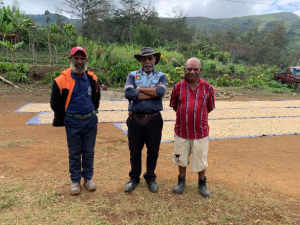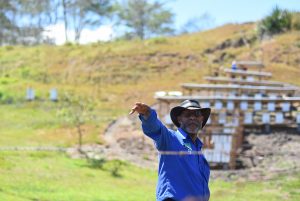If you would like more than 8 samples, please contact a trader directly.
Cart
A trader will contact you with shipping and payment options after checkout. Please note: free samples are provided to commercial roasting businesses only.
As Papua New Guinea gears up for exports, we are busy cupping across smaller cluster group collections in order to determine what components will go into our export lots. This helps us identify standout micro-lots and exclude components that might hurt the lot (defects, cup characteristics, etc). We follow this process with most origins before settling on what we will import. PNG, however, requires more extensive lot planning due to the sheer volume and variety across smaller lots.
Our cupping lab has seen dozens of lots from Papua New Guinea mainly from our principal producer partner, AAAK Cooperative. AAAK supports 4 sub coops and smaller “cluster groups” across the Western, Central, and Eastern Highlands. Lots vary in size from 10 to 200 bags on the specialty side, and 100 to 300 bags on the commercial side. Surprising cups can even be found in economical “Y-Grade” commercial lots—we taste them all.
AAAK has faced significant challenges in the last two years, but the 2020 harvest looks to be their comeback year. Since 2018, AAAK has seen its cooperative membership decline by 702 members. This is mainly caused by removing non-active members and partially due to increased transportation costs in the more remote areas (those requiring airlift). Brian Kuglame, AAAK General Manager, put a positive spin on the reductions noting that the shorter member rolls allow the group to focus on farmers who are serious about farming, quality, and their other mandatory initiatives like family economic planning and detailed record-keeping.
| Peak Harvest | Lot Planning | Shipping/Arrival |
| June-August | August | September/November-January |
This year we’ve seen profiles ranging from “mint, sesame, lemon, spicy black pepper” (Yonki micromill) to “chocolate, orange, papaya” (Keiya Cluster Group) and “squash, tangy passionfruit, big body and complexity” (Kabiufa micromill). We’re about halfway through our lot planning for this year with more samples en route from AAAK and other wet mill suppliers around the Highlands.
New this year, we will be exploring offers from smallholders in the remote outer islands of New Britain, New Ireland, and Bougainville. We couldn’t be more excited to share coffees from regions outside of the typical specialty origins.
AAAK Cooperative felt a major punch to the gut as the national coffee marketing board (Coffee Industry Corporation/CIC) recently took back the land it previously allowed them to use. The large-scale youth engagement center, which was supported by Crop to Cup and several US roasters, was a central site where the coop trains youth and other farmers on agronomy, processing, home building, honeybees, and even fish farming. It all fits into AAAK’s wide-ranging program where coffee is just one element of a family and a village’s economic success. Youth engagement continues, just now in a decentralized format at several regional and village-based sites. We’re proud to continue our support of AAAK.



Lot planning will continue for another three weeks. We look forward to sharing coffees from AAAK, new profiles outside of AAAK’s membership, and new communities from the outer islands.
If we are not already aware of your needs, let us know what you’re looking for. We can advocate for you as final lot selections are made and include you in the Papua New Guinea supply chain. Click here to get in touch with a trader.